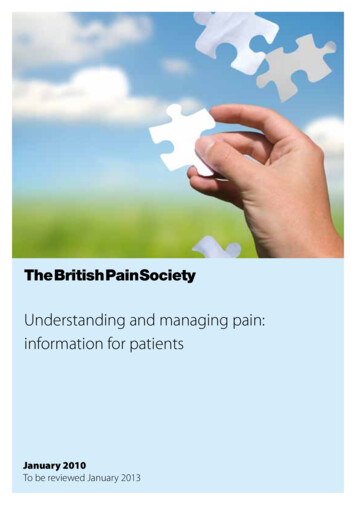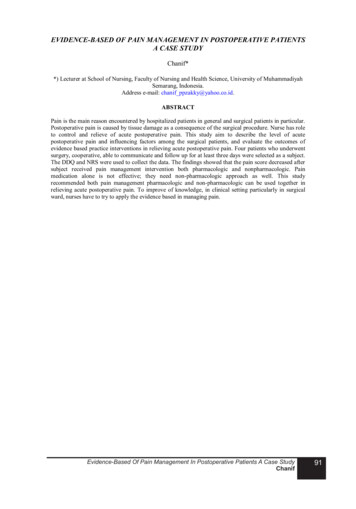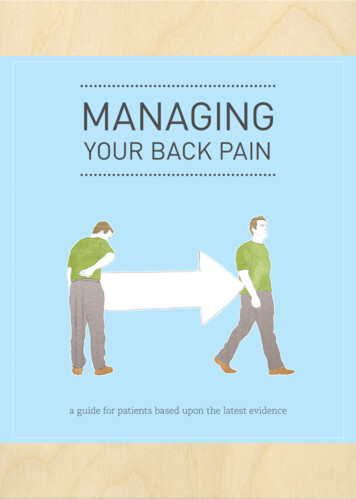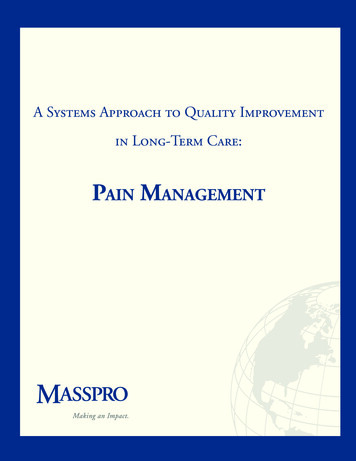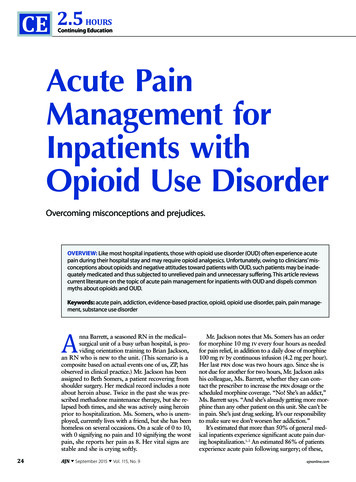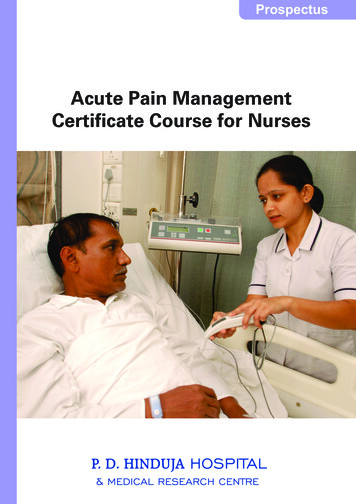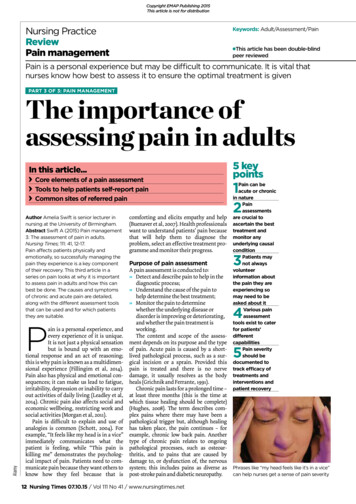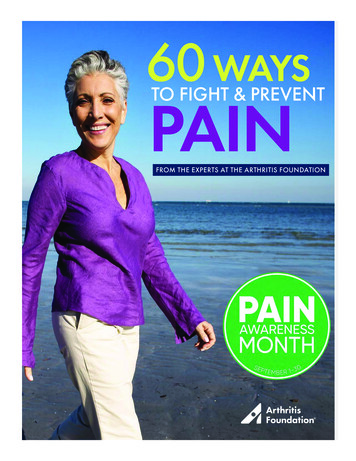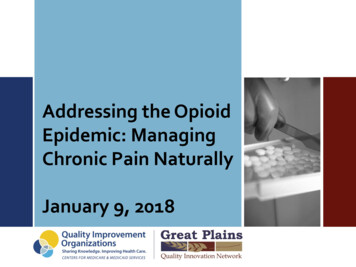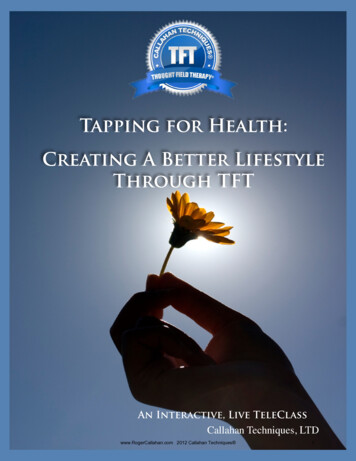
Transcription
Evidence-Based Alternative Pain Management Techniques for Chronic Pain1Evidence-Based Alternative Pain ManagementTechniques for Chronic PainWhat is Chronic Pain?Pain is one way our bodies let us know that something is wrong. It alerts us if we have been injured, or if our bodies needcare. Most pain is short-lived or “acute,” and subsides with minimal effort—but pain that lasts longer or doesn’t go awayas quickly is known as “chronic” pain and can persist for months or even years. Sometimes the pain of a past injury canremain, but other times pain can persist even without prior injury (National Institute of Neurological Disorders and Stroke,2019). The good news is if you or a loved one experiences chronic pain, there are many options available that can lead tolasting relief. This fact sheet will review and explain some of the most successful evidence-based non-opioid methods tomanage chronic pain as identified through rigorous research (e.g., Turk, et al., 2011).
Evidence-Based Alternative Pain Management Techniques for Chronic PainOpioids for Pain ManagementOpioids are a common type of drug prescribed by providers for pain management. They are a synthetic drug made orderived from the opium plant and are a central nervous system depressant, which can reduce the perception of pain andcause drowsiness (Centers for Disease Control and Prevention [CDC], 2018; Nabipour, et al., 2014).Figure 1. Opioid Quick factsSide-effects are common with pharmaceutical-based treatments. Use of opioids may generate:2
Evidence-Based Alternative Pain Management Techniques for Chronic Pain 3Immunosuppression (weakened immune system)Change hormones (i.e. testosterone, estrogen & others)Initiate depressive symptoms Induce Hyperalgesia (increasing pain sensitivity)Sedation and/or abnormal sleep habitsBladder dysfunction and constipationIn rare cases, cardiac issues, or death(Buenadventura, et al., 2008)As such, opioids may not be the best option for patients seeking cost-effective, long-term treatment (Gatchel, et al., 2014).Opioids, including prescriptions, are extremely addictive in nature. If opioids are not used as prescribed, they could leadto a dangerous overdose. According to the Center for Disease Control and Prevention (CDC) over 70,000 people diedof an overdose in 2017 in the United States, almost 70% of these overdoses involved an opioid (Scholl, et al., 2019).In addition, commonly-prescribed opioid medications alone are generally not enough to impact or improve physical andemotional function of most patients suffering from chronic pain (Turk, et al., 2011). Figure 2summarizes the pros and consof opioids, and why they are likely not the best choice for long-term pain management.Figure 2. Pros and Cons of Opioid Usage for Pain
Evidence-Based Alternative Pain Management Techniques for Chronic PainThe Evidence for Alternative Pain ManagementWith these concerns in mind, many have wondered if there are other effective options for pain management. For years,medical options like surgery or opioid medications seemed to be the only options, but steady research has uncoveredmany alternative techniques that can effectively relieve or reduce pain. Alternative techniques for pain management arehighly sought after—but not all are evidence based. To be considered. evidence based, the practice must be rooted inthe best current evidence and demonstrate improvement in the care quality of individual patients (Sackett, et al., 1996).Although we will not address all evidence-based and emerging methods in this fact sheet, we will discuss four evidencebased options that have been identified by researchers at Mayo Clinic (Hooten, 2016; Nahin, et al., 2016) as beinggenerally effective and widely available:1. Cognitive Behavioral Therapy (CBT) for Chronic Pain1. Acceptance and Commitment Therapy (ACT)1. Yoga/Tai Chi1. MindfulnessFor the purposes of this fact sheet, we will be focusing on the four options listed. Other evidence-based options includePhysical Therapy, Acupuncture, and some minimally-invasive medical procedures, which one can explore outside of thissheet (Practice Guidelines for Chronic Pain Management, 2010).Cognitive Behavioral Therapy (CBT):CBT is a structured approach delivered by a licensed mental health professional (e.g. psychologist, social worker, etc.)to help patients understand the thoughts, feelings, and impulses that lead to their behaviors—and restructure or replacethem as needed to improve thinking or behavior patterns (Gatchel, et al., 2014). CBT for chronic pain improves overalldaily functioning and quality of life for a variety of chronic pain conditions (Morley, et al., 1999). If CBT-CP training isn’tlocally available, technology-based delivery of this type of self-management therapy for chronic pain has been proveneffective (Guarino, et al., 2018). Even online CBT when combined with standard medical/medication treatment improvespain management significantly (Guarino, et al., 2018).Though CBT does not reduce overall pain severity, pain is reduced more quickly than with standard treatment. CBT hasbeen shown to lower distressing thoughts about pain, decrease negative substance-related behaviors, and even lowerpain-related emergency department visits (Guarino, et al., 2018). With these evidence-based impacts in mind, personsundergoing pain treatment may consider CBT for their chronic pain.4
Evidence-Based Alternative Pain Management Techniques for Chronic Pain5Acceptance and Commitment Therapy:Acceptance and Commitment Therapy (ACT) is a form of therapy that seeks to help individuals live a meaningful life – allwhile accepting the inevitable pains that life brings (Harris, 2006). Unlike CBT that strives to change thought patterns asneeded, mindfulness-based practices like ACT aim to establish acceptance of one's thoughts and feelings as a health tool(Pollak, et al., 2014). Notably, this approach can be beneficial for acute and even chronic pain management (Vowles, etal., 2019). In a recent study, researchers noted that participants who were given a one-day ACT workshop post-surgeryrequired fewer opioids for pain relief than participants who received treatment as normal (Dindo, et al., 2018). ACT forchronic pain is based on the idea that by learning to live with and accept chronic pain, people can control the grasp thatpain has over their life (Foreman & Kaye, 2016). It is possible that in using ACT and its tools to cope with pain, one maylead a more fulfilling life.Yoga and Tai Chi:Yoga is a type of mind–body meditation practice that began centuries ago in India (Basavaraddi, 2015). It has beenshown to reduce perceived anxiety and stress while also improving mental and physical health (Saoji, 2016). Yogafocuses on breathing, poses, personal discipline, concentration, mindful awareness, meditation, and stillness (Chang, etal., 2016). In one of the earliest studies conducted about the impacts of yoga on chronic pain, Williams and colleagues(2005) first evaluated clinical pain levels of participants, along with their pain-related fears and beliefs about pain. Theythen introduced yoga to these participants, and the yoga intervention showed an overall reduction in medication usage.Their study showed that pain reduction with yoga was two times greater than the educational control group (Williams, etal., 2005). Similar to yoga in some ways, tai chi originated in China, with an emphasis on movement and fluidity of mind/body connections (Lam, 2018). After comparing tai chi to other traditional interventions, tai chi demonstrated some of thehighest gains in relieving chronic pain (Kong, et al., 2016). Though more research is needed about the definitive place ofyoga and tai chi in pain management, they are emerging as evidence-based techniques to aid in pain relief.Yoga and tai chi should be considered for pain management as they require little to no equipment and are generally morecost-effective treatments than other medical interventions. Though it is best to seek classes taught locally (so properinstruction can be given), yoga/tai chi can be done in the comfort of your own home with the help of pre-recorded videosand online-streaming.*
Evidence-Based Alternative Pain Management Techniques for Chronic Pain6Mindfulness:Another technique emerging as an evidence-based technique is mindfulness, which seeks to calm and soothe the mindby emphasizing conscious awareness of the present moment (Harris, 2006; Voss, et al., 2019). There are many typesof mindfulness techniques and activities that can be taught by a broad range of trained instructors and mental healthprofessionals. Mindfulness is central to ACT, and is often practiced with yoga and tai chi, but can be practiced alonethrough mindfulness meditation techniques. In combination with other forms of alternative pain management and even byitself, mindfulness can have a positive impact on reducing chronic pain (Veehof, et al., 2016). Recent studies have shownthat mindfulness may reduce pain intensity, resulting from the way mindfulness skills influence the brain. Some individualsmay even find that their pain experiences become more tolerable as a result of developing mindfulness skills and applyingthem long-term (Veehof, et al., 2016). More research is needed on the effectiveness of mindfulness, but it is a techniquethat can be considered by those looking to improve their pain management.Summary:There are many available therapies for pain relief. Pain management is not one-size-fits all, it is unique-- just like we allare!We have highlighted a few here as a starting place to find what works for you. For a summary of the techniquesdiscussed, please refer to Figure 3 below.
Evidence-Based Alternative Pain Management Techniques for Chronic PainFigure 3. The Four Alternative Pain Management Techniques and Resulting Effects as Compared to OpioidsWhere Can I Learn More?**WebsitesAmerican Pain Society—americanpainsociety.org/American Psychological tional Center for Complementary and Integrative Health—nccih.nih.gov/health/pain/chronic.htmUtah State University Extension—digitalcommons.usu.edu/extension curall/2000BooksThe Mindfulness Solution to Pain: Step-by-Step Techniques for Chronic Pain Management by Jackie Gardner-NixLiving Beyond Your Pain: Using Acceptance and Commitment Therapy to Ease Chronic Painby JoAnne Dahl, PhD &Tobias Lundgren, MSYoga for Pain Relief: A New Approach to an Old Practice by Lee Albert, NMTProgramsLiving Well with Chronic Pain –find a program near you: livingwell.utah.gov7
Evidence-Based Alternative Pain Management Techniques for Chronic Pain*Please consult with your physician prior to making any changes to medication or exercise routine. It may also be helpfulto discuss specific exercises with an expert or medical provider (e.g., medical doctor, physical therapist) to help makepositive changes to your routine that will help with pain reduction or to help you feel healthier.**Please note that all of the resources provided are for educational purposes and USU does not specifically endorsetheir services. The above resources are intended to provide information, not to treat chronic pain or other mental healthconcerns. USU does not control the websites or books referenced above.References Basavaraddi, I. V. (2015). Yoga: Its Origin, History and Development. Ministry of External Affairs, Governmentof India. Retrieved from Yoga Its Origin History and Development Buenadventura, R. M., Adlaka, R. M., & Sehgal, N. M. (2008). Opioid complications and side effects. Painphysician, 11, S105-S120.Centers for Disease Control and Prevention. (2018, December 19). Opioid basics. l Chang, D. G., Holt, J. A., Sklar, M., & Groessl, E. J. (2016). Yoga as a treatment for chronic low back pain: Asystematic review of the literature. Journal of Orthopedics & Rheumatology, 3(1), 1–8. Dindo, Lilian; Zimmerman, M. Bridget; Hadlandsmyth, Katherine; StMarie, Barbara; Embree, Jennie; Marchman,James; Tripp-Reimer, Toni; Rakel, Barbara. (2018). “Acceptance and Commitment Therapy for Prevention ofChronic Postsurgical Pain and Opioid Use in At-Risk Veterans: A Pilot Randomized Controlled Study.” The Journalof Pain, vol. 19, no. 10, Oct. 2018, pp. 1211–1221., doi:10.1016/j.jpain.2018.04.016. Foreman, Evan, and Joanna Kaye. “Treatment: Acceptance and Commitment Therapy for Chronic Pain.” Societyof Clinical Psychology, DIVISION 12 OF THE AMERICAN PSYCHOLOGICAL ASSOCIATION, 2016, mitment-therapy-for-chronic-pain/. Gatchel, R. J., McGeary, D. A., McGeary, C. A., & Lippe, B. (2014). Interdisciplinary Chronic Pain Management.American Psychologist, 69(2), 119–130. doi: 10.1037/a0035514 Guarino, H., Fong, C., Marsch, L. A., Acosta, M. C., Syckes, C., Moore, S. K., Cruciani, R. A., Portenoy, R. K.,Dennis C Turk, D. C., Rosenblum, A. (2018). Web-Based Cognitive Behavior Therapy for Chronic Pain Patients withAberrant Drug-Related Behavior: Outcomes from a Randomized Controlled Trial. Pain Medicine,19(12), 2423-2437.doi:10.1093/pm/pnx334 Harris, Russell. “Embracing Your Demons: An Overview of Acceptance and Commitment Therapy.” Psychotherapyin Australia Hooten, W. M. (2016). Chronic Pain and Mental Health Disorders: Shared Neural Mechanisms, Epidemiology, andTreatment. Mayo Clinic Proceedings, 91(7), 955–970. doi: https://doi.org/10.1016/j.mayocp.2016.04.029 Kong, L. J., Lauche, R., Klose, P., Bu, J. H., Yang, X. C., Guo, C. Q., . . . Cheng, Y. W. (2016). Tai Chi for ChronicPain Conditions: A Systematic Review and Meta-analysis of Randomized Controlled Trials. Scientific Reports,6(1).doi:10.1038/srep25325 Lam, P. (2018, April 13). History of Tai Chi. Tai Chi for Health Institute. Retrieved from i -chi-2/ Morley, S., Eccleston, C., & Williams, A. (1999). Systematic review and meta-analysis of randomized controlledtrials of cognitive behaviour therapy and behaviour therapy for chronic pain in adults, excluding headache. Pain,80(1), 1-13. doi:10.1016/s0304-3959(98)00255-38
Evidence-Based Alternative Pain Management Techniques for Chronic Pain Murphy, J.L., McKellar, J.D., Raffa, S.D., Clark, M.E., Kerns, R.D., & Karlin, B.E. (2014). Cognitive BehavioralTherapy for Chronic Pain Among Veterans: Therapist Manual. Washington, DC: U.S. Department of VeteransAffairs. Nabipour, S., Ayu Said, M., & Hussain Habil, M. (2014). Burden and nutritional deficiencies in opiate addictionsystematic review article. Iranian Journal of P{ublic health, 43(8), 1022–1032. Nahin, R. L., Boineau, R., Khalsa, P. S., Stussman, B. J., & Weber, W. J. (2016). Evidence-Based Evaluation ofComplementary Health Approaches for Pain Management in the United States. Mayo Clinic Proceedings, 91(9),1292–1306. doi: 10.1016/j.mayocp.2016.06.007 National Institute of Neurological Disorders and Stroke. (2019, March 27). Retrieved November 6, 2019, from Chronic-pain-Information-Page. Pollak, S. M., Pedulla, T., & Siegel, R. D. (2014). Three Ways to Bring Mindfulness into Therapy. GreaterGood Science Center at UC Berkeley. Retrieved from e ways bring mindfulness therapy Practice Guidelines for Chronic Pain Management: An Updated Report by the Anesthesiologists Task Force onChronic Pain Management and the American Society of Regional Anesthesia and American Society of Anesthesiaand Pain Medicine (2010). Anesthesiology, 112(4), 810–833. doi: 10.1097/aln.0b013e3181c43103 Sackett, D. L., Rosenberg, W. M., Gray, J. A., Haynes, R. B., & Richardson, W. S. (1996). Evidence basedmedicine: What it is and what it isn’t. BMJ,312(7023), 71-72. doi:10.1136/bmj.312.7023.71 Saoji, A. (2016). Yoga: A Strategy to Cope Up Stress and Enhance Wellbeing Among Medical Students. NorthAmerican Journal of Medical Sciences,8(4), 200. doi:10.4103/1947-2714.179962 Scholl, L., Seth, P., Kariisa, M., Wilson, N., & Baldwin, G. (2019). Drug and opioid-involved overdose deaths—United States, 2013–2017.Morbidity and Mortality Weekly Report, 67(5152), 1419. Turk, D. C., Wilson, H. D., & Cahana, A. (2011). Treatment of Chronic Non-cancer Pain. The Lancet, 377(9784),2226–2235. doi: 10.1016/s0140-6736(11)60402-9 Veehof, M. M., Trompetter, H. R., Bohlmeijer, E. T., & Schreurs, K. M. G. (2016). Acceptance- and mindfulnessbased interventions for the treatment of chronic pain: a meta-analytic review. Cognitive Behaviour Therapy, 45(1),5–31. doi: 10.1080/16506073.2015.1098724 Voss, Maren Wright; Atisme, Kandice; Yaugher, Ashley; and Sulzer, Sandra H., "Mindfulness for Chronic PainManagement" (2019). All Current Publications. Paper 2000.https://digitalcommons.usu.edu/extension curall/2000 Vowles, Kevin; Sowden, Gail; Hickman, Jayne; Ashworth, Julie. (2019). “An Analysis of Within-Treatment ChangeTrajectories in Valued Activity in Relation to Treatment Outcomes Following Interdisciplinary Acceptance andCommitment Therapy for Adults with Chronic Pain.” Behaviour Research and Therapy, vol. 115, Apr. 2019, pp. 46–54., doi:10.1016/j.brat.2018.10.012. Williams, K. A., Petronis, J., Smith, D., Goodrich, D., Wu, J., Ravi, N., . . . Steinberg, L. (2005, May). Effect ofIyengar Yoga Therapy for Chronic Low Back Pain. Pain, 115(1-2):107-17. doi: 10.1016/j.pain.2005.02.016. sAlise Williams Condie, Opioid Education Intern; Kira Swensen, Assistant County Extension Agent, Texas A&M9
required fewer opioids for pain relief than participants who received treatment as normal (Dindo, et al., 2018). ACT for chronic pain is based on the idea that by learning to live with and accept chronic pain, people can control the grasp that pain has

